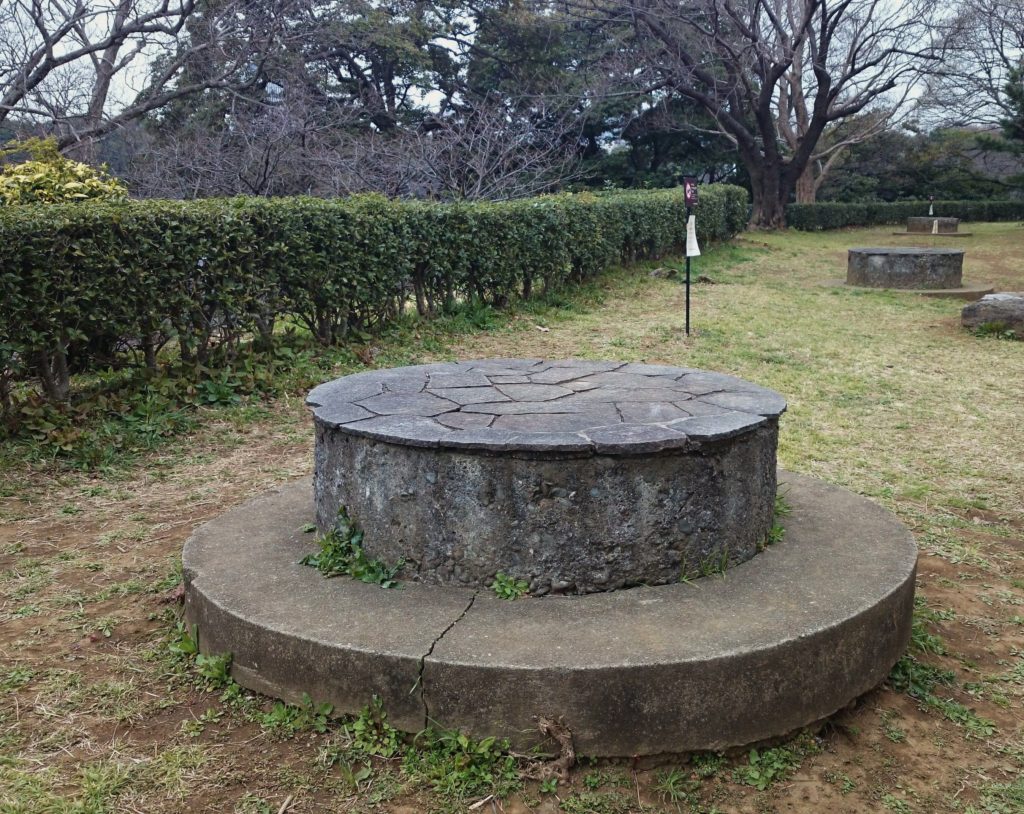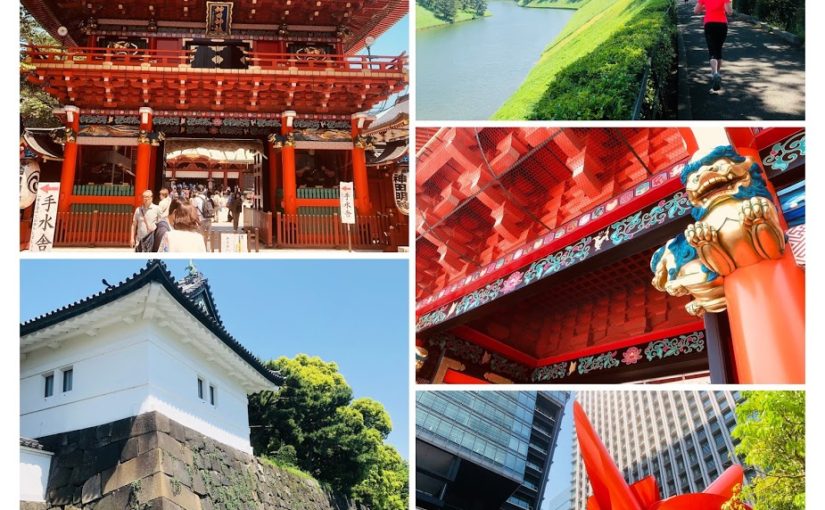I will introduce a special running course that not only enjoys The Imperial Palace, but also runs through Kanda Myojin Shrine and Yasukuni Shrine, two famous shrines, and in the end can relax with japanese public bath.
The running style that uses the public bath is called “Sento running” in Japan, and the person who enjoys it is called “Sento runner”.
The public bath “Aqua House Edo shop” introduced in this article is one of the public baths that can be used as such “Sento running” and JR Ochanomizu Station is nearest.
Click here to know more about “Sento Run”
JR Ochanomizu Station
- area:
- Chiyoda-ku(in Tokyo)
- Genre:
- Running
- LEVEL:
- Beginner
- Traveling time (not including breaks):
- 3 hours
- Distance:
- About 8km
- Access:
- Forward:JR Chuo Line「御茶ノ水駅 Ochanomzu station」
Go out to JR Ochanomizu Station at the Hijiri Bashi exit and go to the left to see “Tokyo Sola City”.
Go down the escalator of “Tokyo Sola City” and you go to the plaza.
Let’s go down the slope named “幽霊坂 Hill of gost” by cutting through the plaza.
By the way, it is written that “Tokyo Landmark Gallery” published in the Meiji Era generally came to be called “幽霊坂 Hill of gost” from the dark and lonely atmosphere at the time.
When you go down this slope you will see “神田アクアハウス江戸遊 Kanda Aqua House Edo-yu” on the right.
Address: 2-9-9 Kanda Awaji-cho, Chiyoda-ku, Tokyo
Opening Hours:11: 00 ~ the next morning 8: 00 (last entrance reception 7: 00)
Closed: open all year round(It may be closed due to maintenance several times a year.)
Admission Fee: 460yen(3 hour restriction)
Tel: 03-3258-2611
Website: http://www.tamanoya.com/
Access: JR Chuo Line · Sobu Line “Ochanomizu Station” 5 minutes on foot from Hijiri-bashi Exit
Tokyo metro · Chiyoda line “Shin-Ochanomizu Station” 5 minutes on foot from “B2 exit”
Tokyo metro · Marunouchi line “Awaji-cho station”, Toei · Shinjuku line “Ogawamachi station” 5 minutes on foot from “A5 exit”
There is a coin locker on the right side as soon as entering the entrance, and you can leave luggage to this coin locker at “神田アクアハウス江戸遊 Kanda Aqua House Edo-yu”.(Four hours 100 yen)
Let’s start out when it gets easy!
Cross the Shouhei bridge and head towards Akihabara.
It was reported that the bridge was first built in this place was Kanei year (1624 – 1645). When the Tokugawa Tsunayoshi built Yushima Seido which is the Confucius Temple in Genroku 4 (1691), “Shouhei bridge” was named after Confucius’s birthplace of “Shōheigō”.
Kanda Myosin Shrine
This shrine was founded in Tenpyo 2nd year (730).
When the battle of Sekigahara occurred in Keicho 5 (1600), Tokugawa Ieyasu prayed for the victory at this shrine and he won the victory on 15th September. Since then he ordered to perform as an auspicious shrine without disappointment.
The main hall appears when you dive in the torii.
Because of a shrine located next to Akihabara in sacred place of animation, anime girl welcomes us.
Yushima Seido
Yushima Seido is a historical site located next to Kanda myoujin.
It is Confucius Temple built in Genroku by the Edo shogunate fifth generic shogun Tokugawa Tsunayoshi, later became an academic center directly under the shogunate.
Leave Yushima Seido’s Gyoukou Gate and go up the slope and pass through under Hijiri-bashi Bridge and go up the stairs beside the bridge.
Nicholai-do
Once you cross Hijiri-bashi Bridge you will find the church “Nicholai-do”.
Nicholai-do is an Orthodox Cathedral located in Kanda Surugadai, Chiyoda Ward, Tokyo. “Nikolai Temple” is a common name, derived from the Russian priest priest, St. Nikolai who brought the teachings of Orthodox to Japan. The official name is “Tokyo Resurrection Cathedral”, it is a cathedral that memorizes the resurrection of Jesus Christ.
Ota Princess Inari shrine
According to the literature, Ota Doukan ‘s daughter suffered from smallpox in the middle of the Muromachi period, wandering around the border of life and death. Doukan heard that Imo-arai-inari Shrine in Kyoto had an inspiration for smallpox and prayed for Imo-arai-inari Shrine to recover her daughter that his daughter’s smallpox cured.
Doukan appreciated this event and built Imo-arai-inari in Edo castle in the first year of Chouroku (1457).
Book Town in Jimbocho
This Book Town has a 130-year history.
It is said that the old book shops targeting many law school students founded in this area in the 1880’s opened one after another,
The feature is that each old book store is not a non-genre, each has a specialized field, and the field is rich in variety, such as literature, philosophy, social science, theater, natural science, foreign books, bunko books is there.
The total number of shops is about 200.
Approximately 140 of them are old book shops and about one third of Tokyo’s old books are concentrated in this area.
It happened that there was a festival of the city on this day, and Omikoshi(a portable shrine) were out.
A huge entrance(torii) of Yasukuni Shrine will appear when you go up the slope.
Yasukuni Shrine is a shrine located in Kudan nourth, Chiyoda-ku, Tokyo, worshiping war deads such as accidents and wars in Japan and abroad as “Eirei”.
you can see a gate door with decoration of chrysanthemum pattern.
The pattern of the chrysanthemum is the emblem of the Imperial Family.
It is the main holl of Yasukuni shrine.
At the exit there is a type of protective dog different from the entrance.
It is the entrance of Kitanomaru Park which was once Edo Castle.
Nippon Budokan
The Nippon Budokan was built as a judo competition venue of the Tokyo Olympic Games in 1964, and is now used as an indoor stadium, concert, multi-purpose hall other than martial arts too.
In the park there is a spacious and relaxing lawn area and a large pond and fountain.
Crafts Gallery, The National Museum of Modern Art, Tokyo
Going through the park there is the “The National Museum of Modern Art”.
The buillding was built as the headquarters building of the Konoe Division in 1910(Meiji 43).
The Konoe Division was said to be a division composed of excellent soldiers selected from all over the country as a guardian of the Emperor.
After the defeat of World War II, the building was designated as an important cultural property in 1972 (Showa 47), and it opened as Tokyo National Museum of Modern Art Crafts Museum in November 15, 1977 (Showa 52 years).
Aircraft cannon pedestal trace of Chidorigafuchi

It is a trace of an aircraft firearm which built to protect the Imperial Palace and surrounding facilities from air raids by the B-29.
During the wartime, the unit that was located here in the Chidorigafuchi camp was “The Konoe Organic Gun No. 1 Battalion” by The Konoe Division.
At the time, the headquarters building of The Konoe Division was the next CRAFTS GALLERY, THE NATIONAL MUSEUM OF MODERN ART.
Miyakezaka
There are beautiful landscape “Miyake Zika” in Area around the Imperial Palace.
Miyakezaka is a slope that goes down Uchibori street from outside Hanzomon to the vicinity of the Metropolitan Police Department. Sakurada moat along the slope is known as a very beautiful scenic spot. It was called Miyakezaka from the fact that there was a mansion of the Miyake family of the Mikawa Tahara lord in the place of the present Supreme Court.
Sakurada-mon Gate
Sakurada-mon Gate is one of the gates built in the moat of Edo Castle and is between Sakurada Moat and Gaisen Moat. In 1956 it was designated as an important cultural asset of the country as “Sakuradamon outside the former Edo castle”.
In Edo castle there are two gates of inside Sakuradamon and outside Sakuradamon, but the former is also called Kikyoumon gate, and in the case of simply “Sakuradamon” it often points to the latter.
You can go under Sakurada Gate in the Edo castle wall.
As soon as we pass the Imperial Palace area, we can see the Tokyo station.
After passing Tokyo Station, we pass the Ootemachi business district.
Iliad Japan
This is a steel monument produced by Alexander Liberman (1912 – 1999) in 1987.”Iliad” is an epic of ancient Greek where Homer ranked the Trojan War.Liberman is a Russian-American photographer and sculptor. Worked as a Vogue art director during the 1940s and 1950s
Crossing the Nihonbashi River is in the Kanda area.
There are many delicious restaurants around here.
Why do not you try going when you finish running?
The picture below is a famous Soba shop “Yabusoba”.
KANDA YABUSOBA
KANDA YABUSOBA is a famous Soba shop in a pure Japanese-style atmosphere.
You can enjoy quality buckwheat using domestically selected buckwheat flour.
Course dishes are also available.
Because KANDA YABUSOBA is expensive,I went to “Topka” famous for Indian curry this day.
Topka
It is a popular menu of pork curry with a sharp spicy.
Address: Takeuchi Building 1F 1-11 Kanda Suida-cho, Chiyoda-ku, Tokyo
Opening Hours: Monday – Friday 11: 00-15: 30/17: 30 – 22: 30 (Izakaya business at night)
Sat, Sun, Holiday: 11: 30 ~ 18: 00
Closed: open all year round
Tel: 03-3255-0707
Website: http://www.tamanoya.com/
Access: Tokyo Metro Marunouchi Line “Awaji-cho Station”, Tokyo Metro Chiyoda Line “New Ochanomizu Station”, Toei Subway Shinjuku Line “Ogawamachi Station” 3 minutes on foot from A3 Exit
7 minutes on foot from JR Chuo Line · Yamanote Line “Kanda Station”
6 minutes on foot from “JR Sobu Line / Yamanote Line” Akihabara Station “
